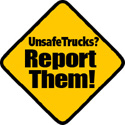LEGISLATIVE INITIATIVES
Overview of Federal Trucking Regulations
The trucking industry must follow the rules and regulations set forward by numerous state and federal laws. Since the laws can vary per state, please click on Find Your State to find the state laws that govern trucks in your state. National regulations can be found in the Federal Motor Carrier Safety Regulations (49 C.F.R. §§ 350-399) at the Federal Motor Carrier Safety Administration website. Here is a review of some of the provision provided by the FMCSA.
49 C.F.R. § 382 - Controlled Substances and Alcohol Use and Testing
This section establishes programs for trucking companies to use that are designed to prevent accidents and injuries resulting from impairment because of the use of alcohol or drugs by commercial vehicle drivers. This is designed for all drivers of commercial vehicles in the US and their employers, with some small exceptions. Drivers who are required to have a commercial drivers license (CDL) under Section 383 must be tested if they drive a vehicle that weighs more than 26,000 pounds, has a gross vehicle range of over 26,000 pounds, is designed to carry 16 or more passengers (including the driver) or is used to carry hazardous materials.
49 C.F.R. § 383 - Commercial Driver's License Standards; Requirements and Penalties
This section lays out the rules and regulations for having a commercial drivers license (CDL), and aims to reduce or prevent truck accidents. Generally, drivers must have a CDL if they drive a vehicle of more than 26,000 pounds, transport themselves and 15 or more passengers or carry hazardous materials. Drivers must be knowledgeable about the various procedures for safe operation of vehicles and be told about the negative effects of driving while fatigued, with poor vision, alcohol or drug use and proper use of the truck's lights, horns, mirrors and other emergency equipment.
49 C.F.R. § 391 - Qualification of Drivers
If a driver operates a tractor trailer or other commercial vehicle that weighs over 10,000 pounds, carries more than 15 passengers or transports hazardous materials, there are certain qualifications. Truck drivers must be at least 21 years old, speak English, be physically able to safely operate a truck, have a valid CDL and must not have been disqualified for any reason, incluing driving while under the influence of alcohol or drugs, committing a felony, leaving the scene of an accident, refusing to take an alcohol test.
49 C.F.R. § 392 - Driving of Commercial Motor Vehicles
A truck driver, the trucking company and all other people in management, maintenance, operation or driving of any commercial motor vehicles or the hiring, supervision, training or dispatching of drivers must comply with federal regulations in order to operate any commercial vehicle that conducts interstate travel, including a tractor trailer, tanker, and straight truck. Drivers must not drive if they are sick or tired and may not use illegal drugs. Drivers must obey traffic laws, load cargo safely, perform periodic inspections and drive cautiously in hazardous conditions. Drivers must be able to stop the vehicle before reaching railroad tracks, must stop when carrying hazardous materials or a trailer and must not shift while crossing railroad tracks.
49 C.F.R. § 395 - Hours of Service of Drivers
This section covers the restrictions related to the hours that a driver is permitted to drive. A driver is not allowed to drive more than 10 hours following 8 straight hours off duty or for any period after having been on duty 15 hours following 8 consecutive hours off duty. A motor carrier cannot require a driver to drive for any period after having been on duty 60 hours in any 7 consecutive days. Further, a driver cannot drive if he has been on duty 70 hours in any period of 8 consecutive days if the motor carrier operates trucks every day of the week. There are also regulations regarding time spent driving in hazardous weather conditions.
A driver is on-duty from the time he or she starts working, not from the time the truck is moving. For example, on-duty time includes:
- Time spent at a loading or unloading facility, or on any property waiting to be dispatched
- Time involved during the inspection process
- Driving time
- All non-driving time spent in a commercial vehicle (except for time spent resting in the sleeper)
- Time spent repairing the vehicle or obtaining help to repair it
- Miscellaneous time, for example, for travel time for taking a drug or alcohol test
- Time performing any work in the employment of a common or private motor carrier
- Time spent performing any compensated work for a non-motor carrier business
